Office of the United States Trade Representative
The Office of the United States Trade Representative (USTR) is the United States government agency responsible for developing and recommending United States trade policy to the president of the United States, conducting trade negotiations at bilateral and multilateral levels, and coordinating trade policy within the government through the interagency Trade Policy Staff Committee (TPSC) and Trade Policy Review Group (TPRG). Established as the Office of the Special Trade Representative (STR) under the Trade Expansion Act of 1962, the USTR is part of the Executive Office of the President. The USTR is headed by the U.S. trade representative, which is a Cabinet-level position, and has over 200 employees, with offices in Geneva, Switzerland, and Brussels, Belgium.
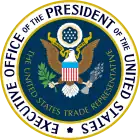 Seal of the Office of the U.S. Trade Representative | |
 Flag of the Office of the U.S. Trade Representative | |
| Agency overview | |
|---|---|
| Formed | 1962 |
| Preceding agency |
|
| Headquarters | Winder Building 600 17th St. NW Washington, D.C. |
| Employees | 200 |
| Annual budget | $54 million (FY 2016) |
| Agency executives |
|
| Parent agency | Executive Office of the President of the United States |
| Website | www |
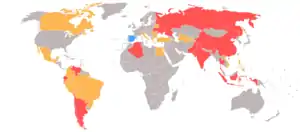
The current acting trade representative is Maria Pagan.[1]
President Joe Biden has announced that Katherine Tai is his nominee for the position.
Organization
Leadership
The head of the office holds the title of United States Trade Representative (USTR), which is a Cabinet-level position, though not technically within the Cabinet, as is the case with office heads not of US departments but rather of offices contained within the Executive Office of the President. To fill the post, the president nominates someone for the position, and the appointment is then approved or rejected by a simple majority of the Senate. The United States trade representative and deputy United States trade representatives (DUSTR) carry the title of Ambassador.
In the Obama administration, Michael Froman served as the US trade representative from 2013 to 2017, with Michael Punke and Robert Holleyman serving as deputy US trade representatives.[2] Ambassador Punke also concurrently served as the U.S. ambassador to the World Trade Organization (WTO). Robert Lighthizer, the current U.S. trade representative, was nominated by President Trump and confirmed by the Senate on May 11, 2017, by a vote of 82–14.[3] On December 10, 2020, Joe Biden announced that he would be nominating Katherine Tai as the United States Trade Representative.[4][5] If confirmed, Tai would be the first woman of color to lead the Office of the United States Trade Representative.
Office of WTO and Multilateral Affairs
The USTR participates in the World Trade Organization, which is currently in the Doha Development Round. This is partially managed by the USTR Office of WTO and Multilateral Affairs (WAMA). Relevant WTO agreements include the Agreement on Trade-Related Aspects of Intellectual Property Rights (TRIPS) and the Generalized System of Preferences.
History of the United States Trade Representative
Trade negotiations became more complicated in the twentieth century with the rise of multilateral organizations and technological advances allowing for more commerce. As a result, the organization of the U.S. government (with Congress in charge of regulating foreign commerce and the executive branch in charge of treaties) became less efficient and in 1962 Congress passed a bill calling for the president to appoint a Special Representative for Trade Negotiations who would make suggestions to the president on the matters of trade.[6] In the 1970s, Congress expanded this position, making it more accountable to Congress (the position has been called "a creature of congress"[7]), and made it cabinet-level. Finally, in 1980 the position was renamed the United States Trade Representative.[6]
The Omnibus Trade and Competitiveness Act of 1988 elevated the position's role to "coordinate trade policy, serve as the President’s principal trade advisor and trade 'spokesperson,' and lead U.S. international trade negotiations."[7] It also "required the USTR to report to both the President and Congress."[7]
Issue areas
- Agriculture
- Economy and trade
- Enforcement
- Environment
- Government procurement
- Industry and manufacturing
- Intellectual property
- Labor
- Preference Programs
- Services and Investment
- Small Business
- Textiles and apparel
- Trade and development
- Trade organizations (The World Trade Organization (WTO), Asia-Pacific Economic Cooperation (APEC), Association of Southeast Asian Nations (ASEAN), and the Organization for Economic Co-operation and Development (OECD).[8]
Reports
National Trade Estimate
The National Trade Estimate Report on Foreign Trade Barriers (National Trade Estimate or NTE) is an annual series prepared by the USTR,which reports significant foreign barriers to U.S. exports. Since 1986, the NTE has provided, where feasible, quantitative estimates of the impact of these foreign practices on the value of U.S. exports. Information is also included on actions taken to eliminate barriers.[9] It is based on information provided by USTR, the U.S. departments of commerce and agriculture, and other agencies and sources.[9]
The Special 301 Report
The Special 301 Report is prepared annually by the USTR under Section 182 as amended of the Trade Act of 1974. The act states that the USTR must on an annual basis, by April of each year:
identify those foreign countries that deny adequate and effective protection of intellectual property rights, or deny fair and equitable markets access to United States persons that rely upon intellectual property protection, and those foreign countries identified under" this "paragraph that are determined by the Trade Representative to be priority foreign countries". The Act defines "priority foreign countries" as "those foreign countries that have the most onerous or egregious acts, policies, or practices that deny adequate and effective intellectual property rights, or deny fair and equitable market access to United States persons that rely upon intellectual property protection, whose acts, policies, or practices described in" this "paragraph have the greatest adverse impact (actual or potential) on the relevant United States products, and that are not entering into good faith negotiations, or making significant progress in bilateral or multilateral negotiations to provide adequate and effective protection of intellectual property rights.[10]
The Uruguay Round Agreement Act furthermore states that countries may be identified under Special 301 "taking into account the history of intellectual property laws and practices of the foreign country, including any previous identifications" and "the history of efforts of the United States, and the response of the foreign country, to achieve adequate and effective protection and enforcement of intellectual property rights". It also states that compliance with the Agreement on Trade-Related Aspects of Intellectual Property Rights does not include a country from being identified as denying "adequate and effective protection of intellectual property rights".[11]
Notorious markets
In 2006, along with the International Intellectual Property Alliance, the USTR published a list of places where large-scale copyright infringement takes place in the Special 301 Report. Since 2010, the notorious markets report has been published as a separate report.
List of United States Trade Representatives
| # | Portrait | Officeholder | Term start | Term End | Days in Office | President(s) | |
|---|---|---|---|---|---|---|---|
| 1 | .jpg.webp) |
Christian Herter | December 10, 1962 | December 30, 1966 | 4 years, 20 days | John F. Kennedy | |
| Lyndon Johnson | |||||||
| 2 |  |
William Roth | March 24, 1967 | January 20, 1969 | 1 year, 302 days | ||
| 3 |  |
Carl Gilbert | August 6, 1969 | September 21, 1971 | 2 years, 46 days | Richard Nixon | |
| 4 |  |
William Eberle | November 12, 1971 | December 24, 1974 | 3 years, 42 days | ||
| 5 |  |
Frederick Dent | March 26, 1975 | January 20, 1977 | 1 year, 300 days | Gerald Ford | |
| 6 | 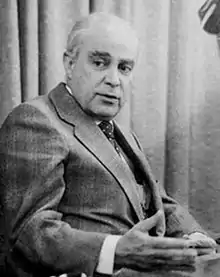 |
Robert Strauss | March 30, 1977 | August 17, 1979 | 2 years, 140 days | Jimmy Carter | |
| 7 |  |
Reubin Askew | October 1, 1979 | December 31, 1980 | 1 year, 91 days | ||
| 8 | 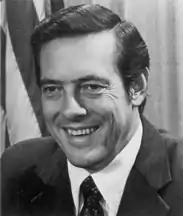 |
Bill Brock | January 23, 1981 | April 29, 1985 | 4 years, 96 days | Ronald Reagan | |
| 9 |  |
Clayton Yeutter | July 1, 1985 | January 20, 1989 | 3 years, 203 days | ||
| 10 |  |
Carla Hills | February 6, 1989 | January 20, 1993 | 3 years, 349 days | George H. W. Bush | |
| 11 |  |
Mickey Kantor | January 22, 1993 | April 12, 1996 | 3 years, 81 days | Bill Clinton | |
| — | 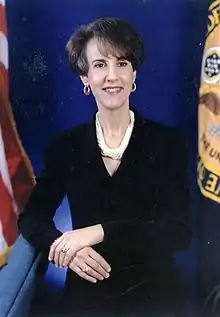 |
Charlene Barshefsky Acting: 1996–1997 |
April 12, 1996 | March 18, 1997 | 340 days | ||
| 12 | April 12, 1996 | January 20, 2001 | 4 years, 283 days | ||||
| 13 | .jpg.webp) |
Robert Zoellick | February 7, 2001 | February 22, 2005 | 4 years, 15 days | George W. Bush | |
| — | .jpg.webp) |
Peter Allgeier Acting |
February 23, 2005 | May 16, 2005 | 113 days | ||
| 14 |  |
Rob Portman | May 17, 2005 | May 29, 2006 | 1 year, 12 days | ||
| 15 |  |
Susan Schwab | June 8, 2006 | January 20, 2009 | 2 years, 196 days | ||
| — | Peter Allgeier Acting |
January 21, 2009 | March 17, 2009 | 55 days | Barack Obama | ||
| 16 | 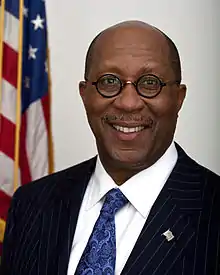 |
Ron Kirk | March 18, 2009 | March 15, 2013 | 3 years, 362 days | ||
| — |  |
Demetrios Marantis Acting |
March 15, 2013 | May 23, 2013 | 100 days | ||
| — |  |
Miriam Sapiro Acting |
May 23, 2013 | June 21, 2013 | 28 days | ||
| 17 | 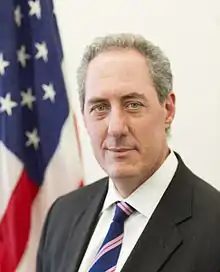 |
Michael Froman | June 21, 2013 | January 20, 2017 | 3 years, 213 days | ||
| — |  |
Maria Pagan Acting |
January 20, 2017 | March 1, 2017 | 40 days | Donald Trump | |
| — |  |
Stephen Vaughn Acting |
March 2, 2017 | May 15, 2017 | 74 days | ||
| 18 | .jpg.webp) |
Robert Lighthizer | May 15, 2017 | January 20, 2021 | 3 years, 250 days | ||
| — | Maria Pagan Acting |
January 20, 2021 | Incumbent | Joe Biden | |||
| — |  |
Katherine Tai | Nominee
Announced December 10, 2020 | ||||
See also
References
- "President Joe Biden Announces Acting Federal Agency Leadership". The White House. January 21, 2021. Retrieved January 23, 2021.
- Obama taps Penny Pritzker, Mike Froman for top economic jobs. CBS News (2013-05-02). Retrieved on 2013-08-12.
- "U.S. Senate: U.S. Senate Roll Call Votes 115th Congress – 1st Session". www.senate.gov. Retrieved September 19, 2017.
- Swanson, Ana (December 9, 2020). "Biden Picks Katherine Tai as Trade Representative". The New York Times. ISSN 0362-4331. Retrieved December 9, 2020.
- Hayashi, Yuka; Restuccia, Andrew (December 9, 2020). "Biden to Name Katherine Tai U.S. Trade Representative". Wall Street Journal. ISSN 0099-9660. Retrieved December 9, 2020.
- Claussen, Kathleen (2017). "Trading Spaces: The Changing Role of the Executive in U.S. Trade Lawmaking". Indiana Journal of Global Legal Studies. 24 (2): 345–368. doi:10.2979/indjglolegstu.24.2.0345. ISSN 1080-0727.
- U.S. Trade Policy Functions: Who Does What? (2020). Congressional Research Service. Retrieved from https://fas.org/sgp/crs/misc/IF11016.pdf on 2021-01-14.
- "Issue Areas | United States Trade Representative". ustr.gov. Retrieved November 14, 2018.
- Office of the United States Trade Representative. "Reports and Publications". Archived from the original on November 11, 2013. Retrieved November 25, 2013.
- Masterson, John T. (2004). International trademarks and copyright: enforcement and management. American Bar Association. ISBN 978-1-59031-359-6.
- Masterson, John T. (2004). International trademarks and copyright: enforcement and management. American Bar Association. pp. 18–19. ISBN 978-1-59031-359-6.
